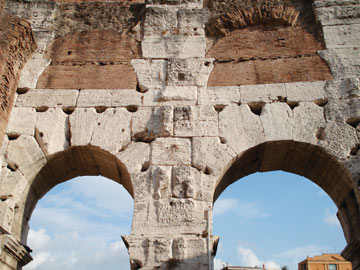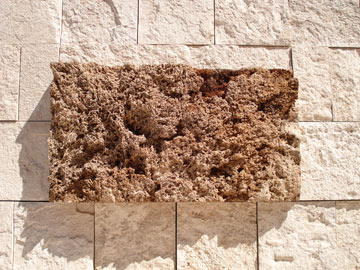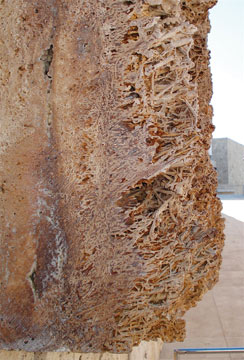|
OFF THE BEATEN PATH
Travertine: A Tie That Binds Two Great Structures
 David Williams |
| The Roman Colosseum in Italy and the Getty Museum in Los Angeles, Calif., share a building stone: travertine. |
 David Williams |
Few building materials in the world have the pedigree of travertine, a type of limestone deposited in hot springs. First used by the Romans thousands of years ago, travertine is still one of the world’s most commonly used building stones, appearing in structures from the Middle East to the Midwest. Two of the most famous travertine structures were built 2,000 years and half a world apart: the Colosseum in Rome, Italy, and the Getty Museum, a $1 billion multi-building complex in Los Angeles, Calif. Travertine alone may not be reason enough to visit these two monumental structures, but it should certainly be noticed if life takes you to either site.
Both the Getty and the Colosseum were built to impress and required years of labor and hundreds of workers (although the Romans finished their project three years faster). Both now attract tourists by the busload. And both are based on geometric shapes — the Getty on the square and the Colosseum on the arch — repeated over and over again, giving the buildings their sight lines, their gravitas and their signature shapes.
But travertine is what fundamentally connects the Getty and the Colosseum. Without travertine, neither would be as stunning, as enchanting or as bold.
The Romans built the Colosseum between A.D. 70 and 80, about 200 years after they first started to quarry the stone. All 100,000 cubic meters of travertine used for the Colosseum came from quarries near the town of Tivoli (then known as Tibur, hence lapis tiburtinus — the stone of Tibur — which later morphed into travertine), 35 kilometers east of Rome on the banks of the Aniene River. The Romans used travertine because it was accessible, easy to cut and able to withstand compression better than any other local rock.
None of these reasons for using travertine applied to Richard Meier, the architect for the Getty. After a worldwide search for stone, Meier chose travertine because he liked its color and texture. His travertine serves an aesthetic purpose rather than a structural one. But like the Romans, Meier acquired his travertine from the quarries outside of Tivoli.
When the Colosseum opened, Emperor Titus celebrated with 100 days of games. When the Getty opened, its owners celebrated with festivities as well. In particular, they celebrated the reviewers’ lavish praise. One wrote that the center “increased your heart rate by its very grandeur,” while others thought the five buildings were the artwork.
Central to the paeans was the use of travertine. Critics rhapsodized about Meier’s worldwide search to “leave no stone unturned” and how he worked with his stone supplier to create the exact look he wanted for the 290,000 pieces of travertine that cover the buildings. None of the critics were geologists, however, and they missed some of the unique features that make the Getty a place to visit.
 David Williams |
|
| Remnants of a hundred-thousand-year-old wetland, including reeds, mosses and algae, can be seen in the building stone at the Getty. | |
|
The Getty’s travertine is unlike any other travertine stone used in buildings in the United States. Most of the blocks measure 76 centimeters by 76 centimeters with a rough-cut exterior surface. They look like sepia-toned, aerial photos of the Desert Southwest, with miniature mesas, plateaus, valleys and ridges. Although most of the blocks are the color of lightly toasted sourdough bread, some have highlights ranging from orange-brown to black, which enhance the three-dimensionality of the panels.
On the Colosseum, in contrast, the Romans used travertine in its more typical style. The color of oatmeal, the Swiss-cheese-textured blocks are cut perpendicular to the rock’s natural bedding, revealing a cross section of bedding. Masons cut each block on site so that the pieces of the arches — the keystones, voussoirs and imposts — fit together as an intricate puzzle, where each piece balances another. In many blocks, you can still see the holes where builders used forceps and levers to lift the blocks into position. (Other holes in blocks indicate where thieves excavated iron dowels and clamps that once held blocks together.) The builders’ attention to detail is further illustrated in how they placed the blocks with their bedding planes aligned with the curve of the arch so that the beds look like rays shooting outward.
Meier did not like the typical, perpendicular-to-bedding cut of travertine, which he associated with building lobbies, such as those in the Seagram Building, Sears Tower and Lincoln Center. For a year, Meier worked with Carlo Mariotti, who had been importing travertine into America from Italy since the 1950s, to develop a guillotine-like machine to crack open blocks of travertine along the bedding planes, akin to opening a deck of cards and seeing the faces.
Because of the cleft stone, geologists have no need to enter the Getty’s galleries. Walk up to any wall and soon you will find a panel rich in fossil leaves. They are so detailed and well preserved you can pick out individual veins and stems and discern if the leaf was upside down or right side up. On some fossil-rich panels, the leaves face in all directions, like leaves that fell in a shallow lake and collected in the bottom ooze. Fabrizio Mariotti, Carlo’s grandson and current co-owner of the company, refers to this phenomenon as seeing “autumn 20,000 years ago.” (Actually, Tivoli’s travertine started forming 200,000 years ago and has continued up to the present with a peak around 80,000 years ago.)
The most amazing panel at the Getty is a 228- by 127-centimeter panel that juts out 25 centimeters from the surrounding panels. To find it, walk to the western side of the arrival plaza and around the back side of the free-standing wall. The giant slab of travertine looks like a jumbled mix of straws, melted wax paper and spaghetti — except that the straws are fossilized reeds, the waxy sheets are fossilized rafts of bacteria and the spaghetti strands are fossilized mosses and algae. White to translucent calcite has filled in some reed tubes either completely or enough to leave only a small hole in the center. The fibrous moss and algal strands cross and crisscross like a spider web. Walking around the Getty you can also find snail and leaf fossils, pea-shaped balls that form in the mouth of a hot springs and solidified gas bubbles. The latter shapes look like round honeycomb.
The critics were correct. Travertine makes Meier’s design succeed. Without it, the Getty would be good architecture; with it, the Getty is great architecture. And no one can doubt the grandeur of the Roman Colosseum — two great structures joined by the same stone.

 Subscribe
Subscribe



